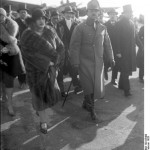Potentaten als Bittsteller (PDF) is a 2001 article about Afghanistan in Der Spiegel.
There is a 1989 photo of the steam engines at Darulaman. The text says:
Amanullah holte deutsche Firmen und Ingenieure ins Land. Sie errichteten Straßen, Brücken, Staudämme und eine königliche Residenz sowie Prachtbauten in Darulaman, einem Vorort von Kabul. Dort sollte auch eine deutsche Eisenbahn fahren, als Lieblingsspielzeug des Potentaten. Die mit dem Schiff nach Bombay transportierten Lokomotiven wurden von Elefanten über enge Passstraßen durch den Hindukusch geschleppt, ein paar hundert Meter Schienenwege verlegt. Noch nach über 20 Jahren Bürgerkriegswirren und der Zerstörung Kabuls standen dort auf einem von Disteln und Dornenbüschen überwucherten Anger drei verrostete Dampfloks und das Fahrgestell eines Reisewaggons „Made in Germany“.
Whch is something vaguely approximating to:
Amanullah sought German companies and engineers into the country. They built roads, bridges, dams
and royal palace in Darulaman, a suburb of Kabul. There should also be a German rail travel, a favourite toy of potentates. The locomtives were transported by ship to Mumbai and then pulled by elephant in passes through the Hindu Kush, where a couple of hundred metres of rail were laid [not sure I’ve got that translation quite right!]. Yet after more than 20 years of civil war turmoil and the destruction of Kabul, there overgrown by thistles and thorn bushes are three rusty steam engines and the carriage labelled “Made in Germany”.
There is a description (in German) of King Amanullah’s visit to Berlin in 1928.
Die politischen Konsultationen verliefen wenig ergiebig. Der Potentat trat als Bittsteller auf. Er brauche Geld, eröffnete der junge König sogleich dem greisen Reichspräsidenten, „Geld zur Entwicklung meines Landes“. Auch wolle er Eisenbahnen bauen. Bei den Eisenbahnen mahnte Hindenburg zur Vorsicht („wenig rentable Unternehmen“), und über besondere Geldmittel verfüge er leider nicht. Aber Deutschland sei gern bereit, Afghanistan „tüchtige Leute“ zur Verfügung zu stellen.
The political consultations were low yielding. The potentate appeared as a supplicant. He needed money, the young king immediately told the aged President [Hindenberg], ‘money to develop my country.” He even wanted to build railways. Hindenburg warned to be cautious about railways (“little profitable business”), and did not have funds. But Germany was happy to provide “capable people”.
(better translations gratefully accepted!)
